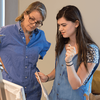
“Mirror Writing” takes a look at the backward handwriting component Schleh uses in most of her artwork. Schleh explained to forensic document examiners how and why she writes in longhand backwards in her drawings, paintings, and prints, expanding upon how handwriting can be understood in terms of drawing and observation.
The 2017 NADE Annual Conference provides continuing education for both members and non-member attendees. The majority of conference attendees are forensic document examiners whose primary purpose of forensic document examination is to answer questions about a disputed document using a variety of scientific processes and methods.
Following a comprehensive analysis of questionable handwriting on different sorts of documents, these document experts offer opinions, reports and court testimony as to whether handwriting on a document may or may not be genuine.
“In order to do what we do well, we must have a rudimentary understanding of certain health issues, kinesiology and writing instruments, and a number of other areas to be able to identify handwriting as having been spuriously written or created,” said Adele A. Thonn, NADE conference chairperson. “In getting to know Karoline, I have found her ability to produce mirror writing fascinating and felt it would be of great interest to the group as well.”
Schleh became first interested in handwriting at a young age from her grandmother teaching her an antiquated German cursive alphabet used in her native village in the Black Forest during the early 1900’s. This love of writing evolved into the “flipped script” used in Schleh’s artwork, which she developed through her training as a printmaker and years of patience and practice.
“I was trained academically as a young artist, with lots of life drawing and photo realism study in the 1980’s. While most of my drawing and painting work I produce now is highly abstracted and atmospheric, I also create small photo realism oil paintings for my painting classes at Loyola as demonstrations specifically to discuss not only materials and technique, but also to begin the conversation on understanding the concepts of observation and representation,” said Schleh. “These are principles that an artist can use to create a beautiful drawing and are the same fundamental principles needed to determine if something is a copy.”
Schleh’s expertise in handwriting allowed forensic document examiners to understand the formal aspects of script writing from the perspective of an artist. While both Schleh and Thonn look at drawing and writing with different motives, understanding the fundamentals and components of how script writing is done is essential in both their fields of work.